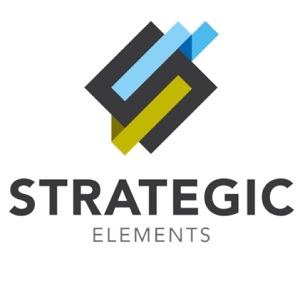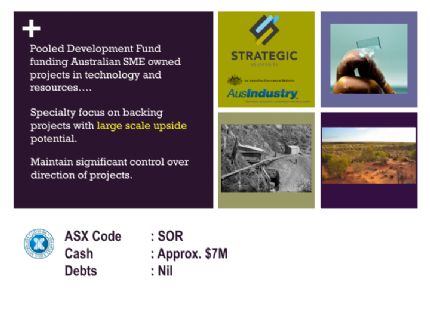 Successful Progress of Nanocube Memory Ink Program
Successful Progress of Nanocube Memory Ink Program
Perth, Oct 9, 2015 AEST (ABN Newswire) - Strategic Elements ( ASX:SOR) is pleased to report that nanocube memory ink has been successfully printed onto silicon wafer with an ink jet printer. Even at this first step, the printed device is showing RRAM memory functionality. The program has now progressed to fabricating and optimising prototypes prior to testing.
ASX:SOR) is pleased to report that nanocube memory ink has been successfully printed onto silicon wafer with an ink jet printer. Even at this first step, the printed device is showing RRAM memory functionality. The program has now progressed to fabricating and optimising prototypes prior to testing.
The UNSW team has previously developed a memory ink containing nanocubes, however this is the first time that the nanocube ink has been successfully inkjet printed onto silicon. The inkjet printer successfully fabricated thin films with nanocubes self-assembling within the ink. The thickness of the inkjet printed nanocube film is much thinner than ever developed before due to the machine-controlled printing process.
Further optimisation is underway.
Significant technical challenges were overcome by the team at UNSW to enable initial ink jet printing of a nanocube solution with new intellectual property being developed in the process. The Company will disclose any relevant new patent from this work at the appropriate time.
Technical challenges overcome that can be disclosed at this time include:
1. Optimising voltage to control and select optimal nozzle configuration,
2. Optimising ink spot size to assist consistency,
3. Adjusting surface tension to assist ink uniformity, and
4. Utilizing UV light to reduce organic material.
SOR is the only Company on ASX successfully developing a Printed Electronic technology and recognises the scale of the opportunity for its technology may not yet be fully appreciated.
Most memory components today are manufactured through a process, which is very expensive, and results in memory solutions that are not flexible or transparent. However, due to consumer demand, large product manufacturers are requiring new memory components that are transparent and/or can be included into flexible, bendable products. Likewise, critical industries such as health, defence and energy are seeking hybrid solutions to combine printed materials with traditional silicon, circuitry and other solutions.
The enormous potential scale of printed electronics however, is only understood by recognising the many industries that will be disrupted that have previously only had limited opportunity to include electronics in their products. Examples include glass or textile manufacturing.
The nanocube ink program is actively progressing and the Company will update the market as appropriate.
Company Comment
Managing Director Charles Murphy said, "It's really encouraging to be at this point in the program. A short time ago it was only 'in principle' that the nanocube technology could be printed using an inkjet printer. Here we are today with a nanocube ink that can actually be printed and even at its earliest form has memory functionality.
Importantly, the type of memory being developed (RRAM) has potential to scale up for very high performance in comparison to current printed memory technologies".
Why is Strategic Elements Different to Other Companies?
Most shareholders pay no capital gains tax when they sell their shares in ASX listed Strategic Elements ( ASX:SOR). They also pay no tax on dividends they receive.
ASX:SOR). They also pay no tax on dividends they receive.
The Company has a special registration from the Federal Government as a Pooled Development Fund. It operates under a program designed to increase investment into Australian companies by providing government legislated tax incentives to Pooled Development Fund shareholders. Full information can be found on the Company website.
Nanocube Technology
The Nanocube material, made from cerium oxide, is comprised of tiny cubes that are roughly 10 nanometres thick, or about 10,000 times smaller than the thickness of a sheet of paper. When placed in a solution and deposited onto a conductive surface via ink-jet printer, the cubes self-assemble: first they form a coordinated square array, then they stack on top of each other like Lego, building up layer by layer.
The Company believes there is no commercially ready printable memory with the potential of the nanocube memory technology. Printed electronics have already reached mass production, but with very limited memory performance. High-performance printable memory will be a significant breakthrough. Leading research firm IDTechEx forecasting the total printed electronics market will grow from $16 billion in 2003 to $76.79 billion by 2023.
100% owned Australian Advanced Materials (AAM) has an exclusive global licence for the technology from UNSW and has contracted the materials group at the UNSW School of Materials Science and Engineering to assist in developing a nanocube memory prototype, improving the technology and creating new intellectual property.
About Strategic Elements Ltd
 Strategic Elements (ASX:SOR) shares are listed on the Australian Stock Exchange under the code “SOR”. The Company is registered under the Pooled Development Program run by the Australian Federal Government to encourage investment into SME’s. To assist Pooled Development Fund’s to invest and raise capital, the Federal Government enables most shareholders in a Pooled Development Fund to make capital gains and receive dividends tax-free.
Strategic Elements (ASX:SOR) shares are listed on the Australian Stock Exchange under the code “SOR”. The Company is registered under the Pooled Development Program run by the Australian Federal Government to encourage investment into SME’s. To assist Pooled Development Fund’s to invest and raise capital, the Federal Government enables most shareholders in a Pooled Development Fund to make capital gains and receive dividends tax-free.
![abnnewswire.com]()
Related Companies
Social Media
Share this Article

 ASX:SOR) is pleased to report that nanocube memory ink has been successfully printed onto silicon wafer with an ink jet printer. Even at this first step, the printed device is showing RRAM memory functionality. The program has now progressed to fabricating and optimising prototypes prior to testing.
ASX:SOR) is pleased to report that nanocube memory ink has been successfully printed onto silicon wafer with an ink jet printer. Even at this first step, the printed device is showing RRAM memory functionality. The program has now progressed to fabricating and optimising prototypes prior to testing. ASX:SOR). They also pay no tax on dividends they receive.
ASX:SOR). They also pay no tax on dividends they receive. Strategic Elements (ASX:SOR) shares are listed on the Australian Stock Exchange under the code “SOR”. The Company is registered under the Pooled Development Program run by the Australian Federal Government to encourage investment into SME’s. To assist Pooled Development Fund’s to invest and raise capital, the Federal Government enables most shareholders in a Pooled Development Fund to make capital gains and receive dividends tax-free.
Strategic Elements (ASX:SOR) shares are listed on the Australian Stock Exchange under the code “SOR”. The Company is registered under the Pooled Development Program run by the Australian Federal Government to encourage investment into SME’s. To assist Pooled Development Fund’s to invest and raise capital, the Federal Government enables most shareholders in a Pooled Development Fund to make capital gains and receive dividends tax-free.




